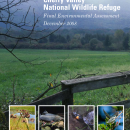What We Do
Wildlife conservation is at the heart of the National Wildlife Refuge System. It drives everything on U.S. Fish and Wildlife Service lands and waters managed within the Refuge System, from the purposes for which a national wildlife refuge national wildlife refuge
A national wildlife refuge is typically a contiguous area of land and water managed by the U.S. Fish and Wildlife Service for the conservation and, where appropriate, restoration of fish, wildlife and plant resources and their habitats for the benefit of present and future generations of Americans.
Learn more about national wildlife refuge is established to the recreational activities offered to the resource management tools used. Using conservation best practices, the Refuge System manages Service lands and waters to help ensure the survival of native wildlife species.
Refuges deploy a host of scientifically sound management tools to address biological challenges. These tools span active water management to wilderness character monitoring, all aimed at ensuring a balanced conservation approach to benefit both wildlife and people.
Management and Conservation
Refuges deploy a host of scientifically sound management tools to address biological challenges. These tools span active water management to wilderness character monitoring, all aimed at ensuring a balanced conservation approach to benefit both wildlife and people.
The majority of habitat management conducted at Cherry Valley National Wildlife Refuge consists of controlling natural succession, which threatens sensitive wetland habitats and open fields with encroachment by woody vegetation such as shrubs and trees. Cutting back vegetation in these areas helps to maintain the diverse mosaic of wetland and upland habitats that wildlife depend on. Techniques include mowing, manual cutting, and application of specific herbicides where necessary to limit re-growth of woody vegetation.
The U.S. Fish and Wildlife Service acquired the first tract of land for Cherry Valley National Wildlife Refuge on October 18, 2010. We will determine the start date for the Cherry Valley Planning Process in the future. Please check back for more information.
Our Projects and Research
- Cherry Valley National Wildlife Refuge was established in part to protect the federally threatened bog turtle, which can be found in wetlands throughout the valley. Due to their listed status, refuge public use areas are located away from sensitive bog turtle habitats. Refuge staff also monitor wood and box turtle populations on the refuge.
- The Kittatinny Ridge (which flanks the south side of the valley) has been designated an Important Bird Area by the Pennsylvania Audubon Society, and is a well-known migration flyway that concentrates up to 20,000 migrating raptors and more than 140 bird species every fall. Refuge staff and volunteers monitor the migrating bird populations with assistance from the Friends of Cherry Valley NWR and the Pocono Avian Research Center.
- The valley’s ridges and hills are cloaked in mixed hardwood and conifer forest, while chestnut oak, gray birch, quaking aspen, white pine, and pitch pine populate flat ridge tops once cleared for pasture and logging. Some juniper and Virginia pine can be found on recently abandoned farmland. Oaks, red maple, black cherry, hemlock and tulip poplar dominate in other areas. These upland forests are the most common habitat type and total nearly 18,800 acres, nearly 60 percent, of the valley. Sections of the refuge are being converted to warm-season grass and wildflower meadows. All habitats are being managed for invasive species invasive species
An invasive species is any plant or animal that has spread or been introduced into a new area where they are, or could, cause harm to the environment, economy, or human, animal, or plant health. Their unwelcome presence can destroy ecosystems and cost millions of dollars.
Learn more about invasive species , with the main target species being Japanese Barberry and Mugwort. - In most areas of the valley, riparian riparian
Definition of riparian habitat or riparian areas.
Learn more about riparian vegetation is well‐established and stable, providing a thick canopy important to fish. In addition to streams and creeks, a variety of forested and open wetlands are found in the valley bottom and total nearly 1,750 acres. These wetlands host a variety of wildlife including waterfowl, wading birds, river otter, beaver, and several dozen species of reptiles and amphibians. Vernal pools are also scattered across the valley, supporting a number of salamander, frog, turtle, and snake species. Refuge staff and volunteers, as well as the Brodhead Chapter of Trout Unlimited, are restoring sections of the Cherry Creek.
Law Enforcement
Injured wildlife or wildlife crimes may be reported to refuge staff located at the Wallkill River National Wildlife Refuge office, 973-702-7266.
Laws and Regulations
- Service animals (those that have been individually trained to do work or perform tasks for an individual with a disability; the task(s) performed by the service animal must be directly related to the person’s disability) are allowed in all areas of the refuge that are open to the public, including refuge parking lots, road, trails, and visitor centers.
- Pets (non-service animals) are not allowed on any refuge trails or in the visitor center.
- No overnight parking is allowed.
- Use of motorized vehicles is prohibited. Motorized vehicles disturb wildlife, cause erosion, disturb other refuge visitors, and shatter the tranquility of the refuge.
- Jogging, bicycling, and horseback riding is not allowed on refuge trails. These activities may disturb visitors and wildlife and erode trails.
- It is against the law to damage archaeological sites or remove artifacts such as old bottles or arrowheads on the refuge. Please help protect sites by leaving artifacts in place and reporting locations to refuge staff.
- Marijuana on Federal Lands: regarding the use and possession of marijuana on Federal lands, possession of marijuana or use of any amount of marijuana along with all other Schedule I illegal drugs is still prohibited in Cherry Valley NWR (Federal lands) to include but not limited to its facilities and lands. Violations are punishable by a fine or imprisonment, or both, 50 CFR 27.82 (b)(2), 16 U.S.C. 551, 18 U.S.C. 3559 and 3571.


